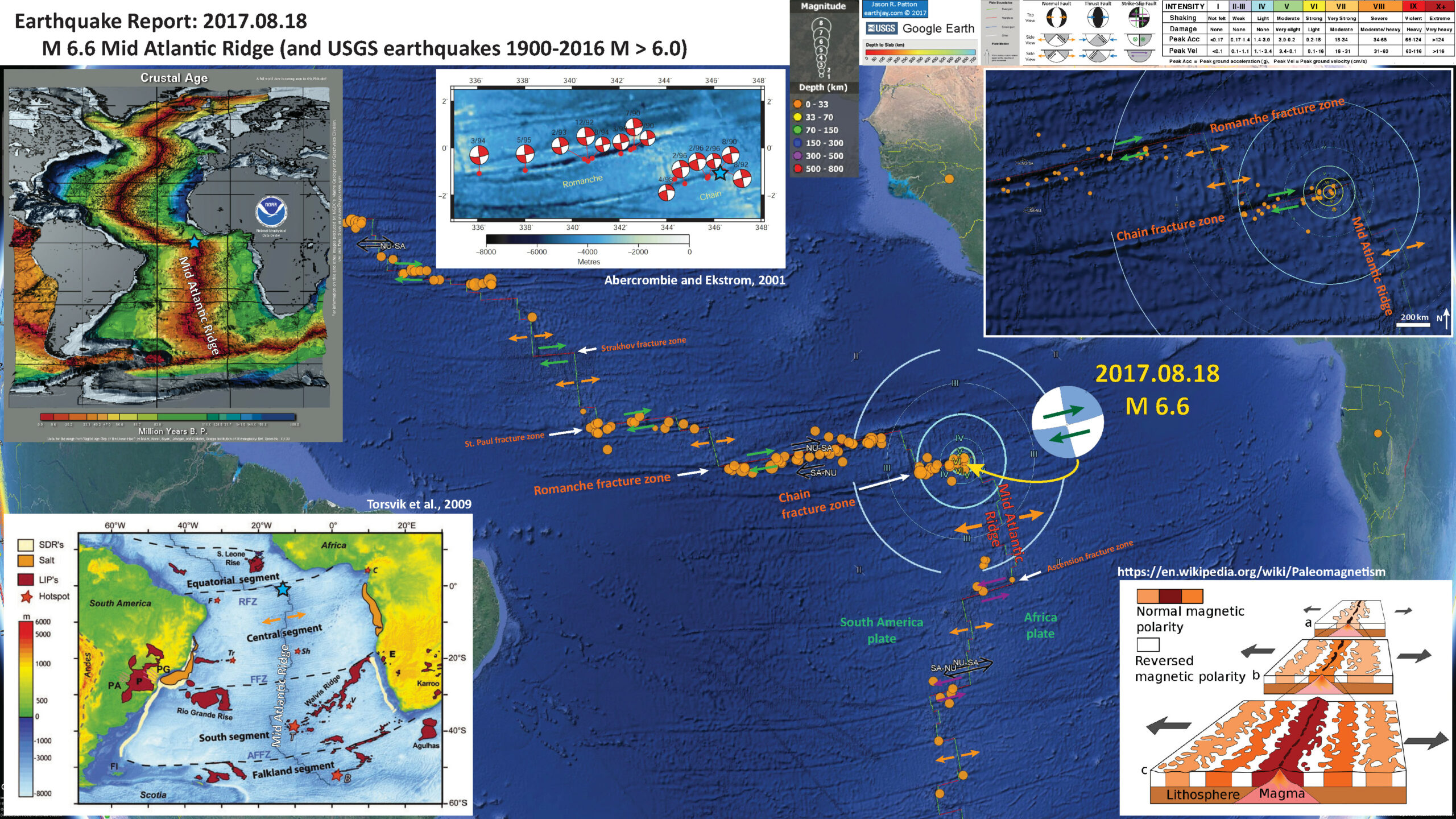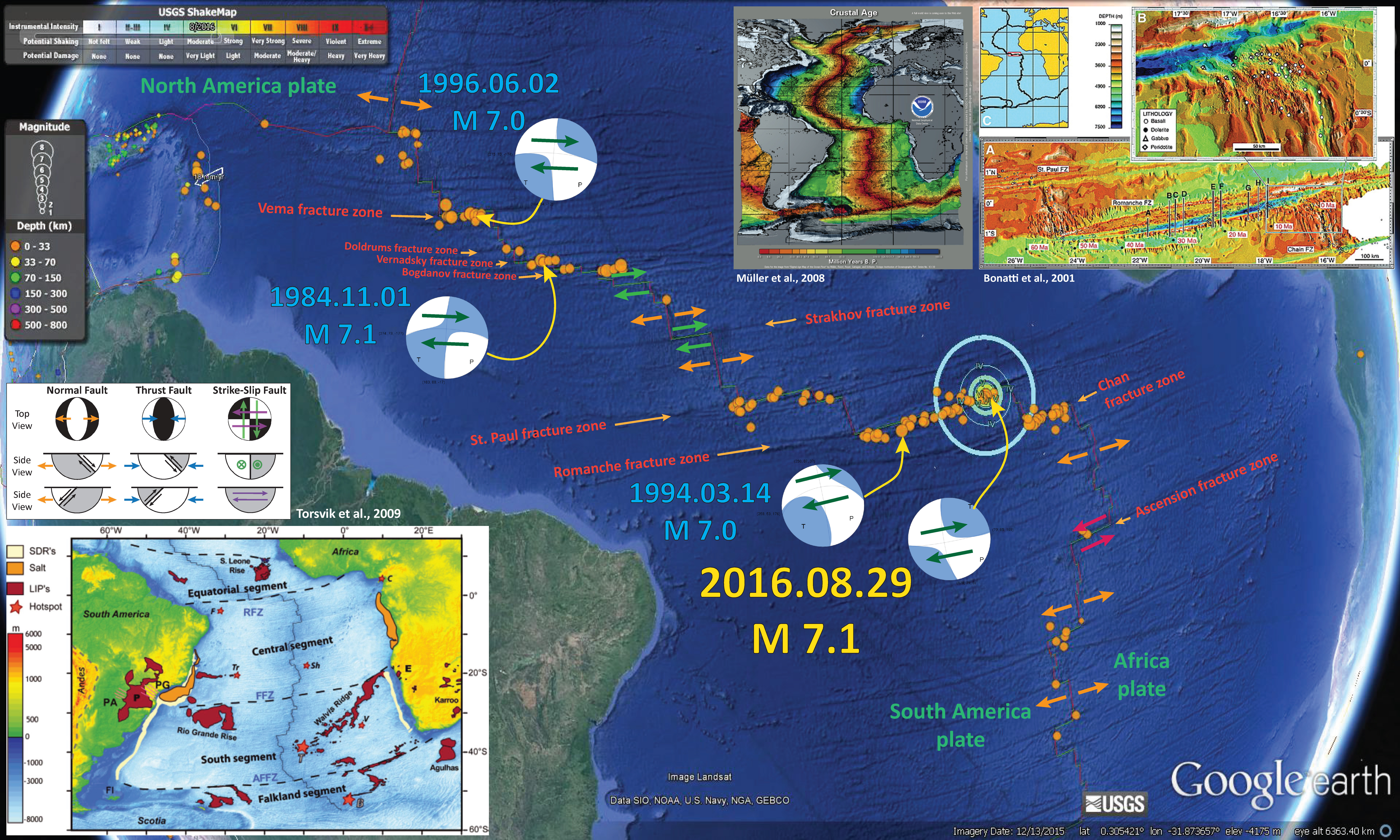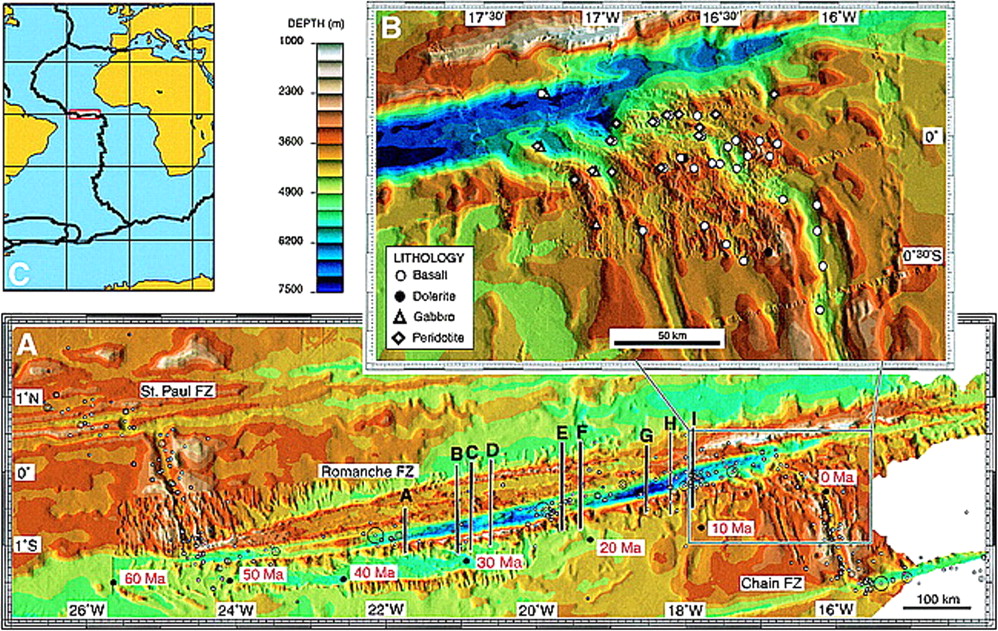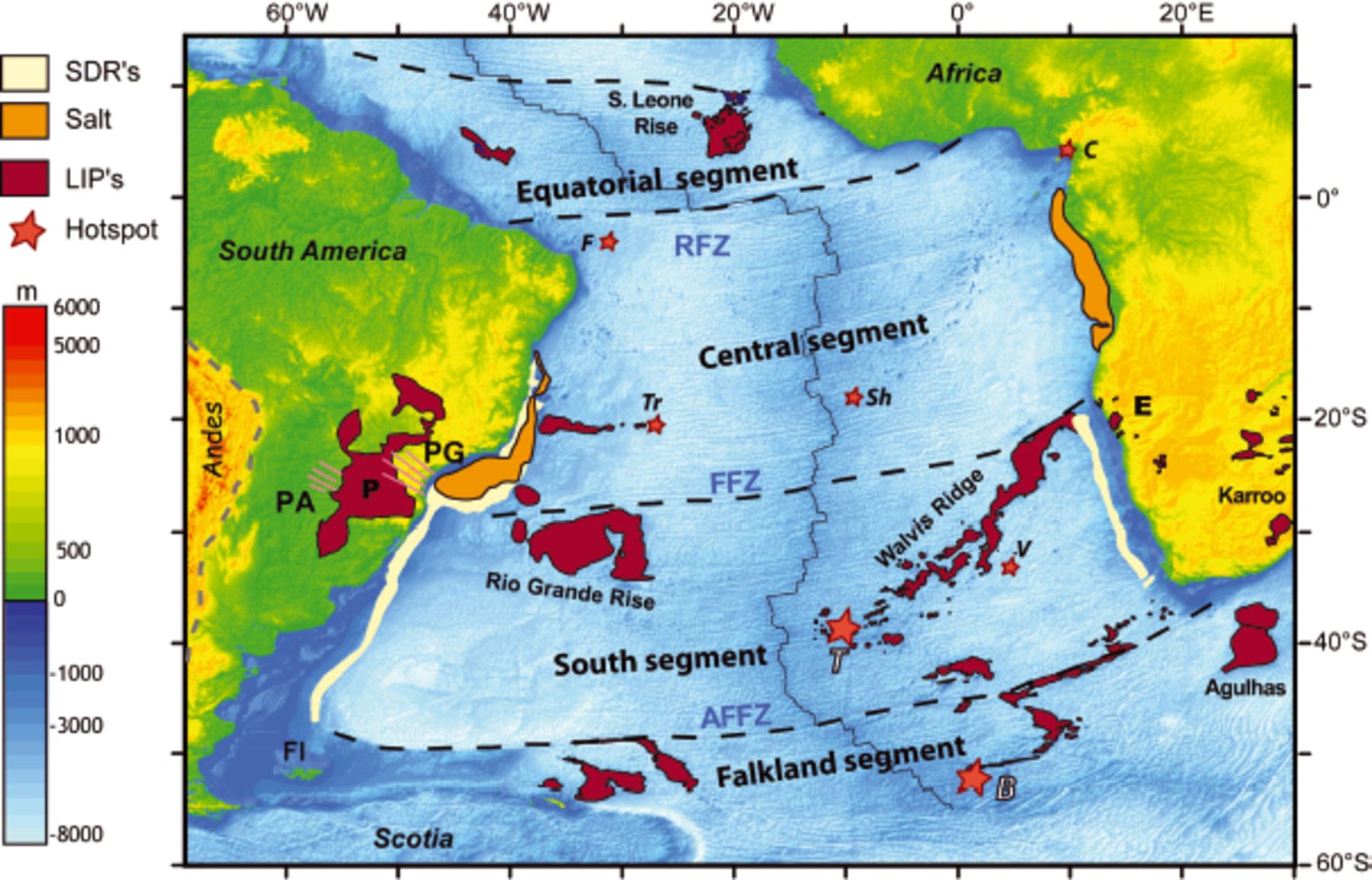If there was an earthquake in the middle of the ocean, and nobody felt it… would it still be an earthquake? Maybe we need to get the Karl Popper out for a good read…
There was a good sized shaker less than an hour ago (at the time I started writing this, when it was first estimated to be M 6.8). Here is the USGS website for the M 6.6 earthquake that appears to be associated with the Chan fracture zone.
This may be related to a recent earthquake on the Romanche fracture zone, but it is probably too far away. Here is my report for this M 7.1 earthquake from 2016.08.29.
Below is my interpretive poster for this earthquake
I plot the seismicity from the past month, with color representing depth and diameter representing magnitude (see legend). I also include USGS epicenters from 1900-2016 for magnitudes M ≥ 6.0.
I also include the USGS moment tensor for today’s earthquake.
- I placed a moment tensor / focal mechanism legend on the poster. There is more material from the USGS web sites about moment tensors and focal mechanisms (the beach ball symbols). Both moment tensors and focal mechanisms are solutions to seismologic data that reveal two possible interpretations for fault orientation and sense of motion. One must use other information, like the regional tectonics, to interpret which of the two possibilities is more likely. Based upon the series of earthquakes and the mapped faults, I interpret this M 5.1 earthquake as a left-lateral strike-slip earthquake related to slip associated with the Gorda plate.
- I also include the shaking intensity contours on the map. These use the Modified Mercalli Intensity Scale (MMI; see the legend on the map). This is based upon a computer model estimate of ground motions, different from the “Did You Feel It?” estimate of ground motions that is actually based on real observations. The MMI is a qualitative measure of shaking intensity. More on the MMI scale can be found here and here. This is based upon a computer model estimate of ground motions, different from the “Did You Feel It?” estimate of ground motions that is actually based on real observations.
- In the upper left corner is a map that shows the age of the oceanic crust in Million Years B.P. (before present). The MAR is highlighted because it is of about zero age, so is shown as red (Müller et al., 2008). I place a blue star in the general location of this M 6.6 earthquake (as for the other inset maps).
- In the lower left corner is a map that shows a revised interpretation of the timing and orientations of the initial breakup and formation of the MAR and the Atlantic Ocean from Torsvik et al. (2009)
- In the lower right corner is a diagram that illustrates how Earth’s magnetic field reversals are recorded in the oceanic crust through time. This is one of the principal evidences that supports the hypotheses regarding plate tectonics. From top to bottom (earlier in time to later in time, where t = some time).
- t = 0 Earth’s magnetic field is the same as it is today. We term this “normal” polarization. Rocks (and sediments) formed at this time can have magnetic minerals and grains align with the magnetic field orientation at that time.
Colored oceanic crust (in this diagram) represents crust formed when the magnetic field is oriented like it is today. - t = 1 Tens of thousands to hundreds of thousands years later, as the plates diverge from the spreading ridge, decompression melting leads to accretion of new oceanic crust at the ridge. At this time, the magnetic field has reversed (north pole becomes south pole, dogs and cats living together (from movie “Ghostbusters”)), so the oceanic crust rock is magnetized with a field oriented opposite from the way it is today. We term this crust to have “reverse” polarization. Then, the magnetic field flips orientation again, becoming normal again. The diagram shows at this time, the crust forming at the ridge is normally polarized.
- t = 2 Tens of thousands to hundreds of thousands years later, the plates continue to diverge from the spreading ridge forming new crust, and there are additional cycles of flipping magnetic fields. The result is a pattern, symmetrical about the spreading ridge, of oceanic crust that has alternating bands of crust with different polarities.
- In the upper center is a map that shows the two fracture zones in this region (Romanche and Chain) along with focal mechanisms for earthquakes along these fracture zones. The fracture zones, which offset the Mid Atlantic Ridge (MAR), are transform plate boundaries. Considering the orientation of these fracture zones and the MAR, these earthquakes are right-lateral strike-slip earthquakes. Today’s M 6.6 earthquake is no different. Note how this earthquake is nearly perfect strike slip.
- In the upper right corner is a larger scale map that shows the details of the sea floor in this region.The majority of the seismicity occurs along the fracture zones, which offset the MAR. Today’s earthquake is most likely associated with strike-slip faulting along the Chan fracture zone.
I include some inset figures in the poster.
- Here is the interpretive poster from the M 7.1 earthquake from 2016.08.29.
- Here is the Bonatti et al. (2001) figure from the interpretive poster above. I include the figure caption as a blockquote below.
A: Multibeam topography of Romanche region, showing north-south profiles where sampling was carried out. Black dots and red numbers indicate estimated age (in million years) of lithosphere south of Romanche Transform, assuming spreading half-rate of 17 mm/yr within present-day ridge and transform geometry. White dots indicate epicenters of teleseismically recorded 1970–1995 events (magnitude . 4). FZ is fracture zone. B: Topography and petrology at eastern intersection of Romanche Fracture Zone with Mid-Atlantic Ridge. Data were obtained during expeditions S-16, S-19, and G-96 (Bonatti et al., 1994, 1996). C: Location of A along Mid-Atlantic Ridge.
- Here is the Torsvik et al. (2009) figure from the interpretive poster above. I include the figure caption as a blockquote below.
General structural map of the South Atlantic Ocean draped on topographic/bathymetric map from GTOPO 30. Boundaries between the four segments (Equatorial, Central, South and Falkland) are shown by dotted lines (RFZ, Romanche Fracture Zone; FFZ, Florianopolis Fracture Zone; AFFZ, Agulhas– Falkland Fracture Zone). Aptian salt basins (orange), LIPs (P, Parana; E, Etendeka; Karroo, Sierra Leone Rise and Agulhas), Seaward Dipping Reflectors (SDRs, white) and active hotspots (F, Fernando; C, Cameroon; Tr, Trinidade; Sh, St Helena; T, Tristan; V, Vema; B, Bouvet (Meteor) are also shown. Of these hotspots, only Tristan (responsible for the Parana-Etendeka LIP and Rio Grande Rise–Walvis Ridge) is classically considered as a deep plume in the literature (see Torsvik et al. 2006). However, Bouvet (Meteor) possibly responsible for Agulhas, and Maud Rise (East Antarctica) and Madagascar Ridge volcanism could possibly also have a deep plume origin (Section 6). PG, Ponta Grossa Dyke System; PA, Paraguay Dyke system; FI, Falkland Islands.
- I created an animation that shows the seismicity for this region of the MAR from 1900-2016.08.29. The animation includes earthquakes of magnitudes M ≥ 6.0. Here is the kml that I created from the USGS website. Below is a map of all the earthquakes plotted, with the animation below.
- Here is a link to the video embedded below (4 MB mp4)
- 2017.08.18 M 6.6 Mid Atlantic Ridge (Chan fracture zone)
- 2016.08.30 M 7.1 Mid Atlantic Ridge
- 2015.06.18 M 7.0 Mid Atlantic Ridge
- 2015.05.24 M 6.3 Mid Atlantic Ridge
- 2015.02.13 M 7.1 Mid Atlantic Ridge
Earthquake Reports: Atlantic
Earthquake Reports
- Abercrombie, R.E. and Ekstrom, G., 2001. Earthquake slip on oceanic transform faults in Nature, v. 410, p. 74-77
- Bonatti, E., Brunelli, D., Fabretti, P., Ligi, M., Portaro, R.A., and Seyler, M., 2001. Steady-state creation of crust-free lithosphere at cold spots in mid-ocean ridges in Geology, v. 29, no. 11, p. 979-982.
- Müller, R.D., Sdrolias, M., Gaina, C., and Roest, W.R., 2008. Age, spreading rates and spreading symmetry of the world’s ocean crust in Geochem. Geophys. Geosyst., 9, Q04006, doi:10.1029/2007GC001743
- Torsvik, T.H., Tousse, S., Labaila, C., and Smethurst, M.A., 2009. A new scheme for the opening of the South Atlantic Ocean and the dissection of an Aptian salt basin in Geophysical Journal INternational, v. 177, p. 1315-1333.






